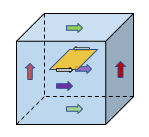The Möbius band is a one-sided surface when embedded in our familiar three-dimensional space. But what about when it’s embedded in a different space? The containing space matters since this is the space that the ant walks in as it traverses the Möbius band. After all, the ant doesn’t live in the Mobius band but in the space above it.
The space we have at hand to consider is the 3-torus. When the Möbius strip is embedded in the 3-torus, it remains one-sided. When the following program loads, we’re placed back inside a 3-torus and sharing this space with a Möbius band.
The Möbius band spans the width of the space. Its two ‘ends’ are glued together where they meet a pair of the 3-torus’s glued faces. An ant walking the length of the band crosses from one color to the other, and finds itself where it starts but on the opposite side. Walking one more length of the Möbius band, it returns to its starting point.
The program lets you populate the 3-torus with twisted bands. Those with an even number of half-twists are two-sided whereas those with an odd number of half-twists (such as the Möbius band) are one-sided.
